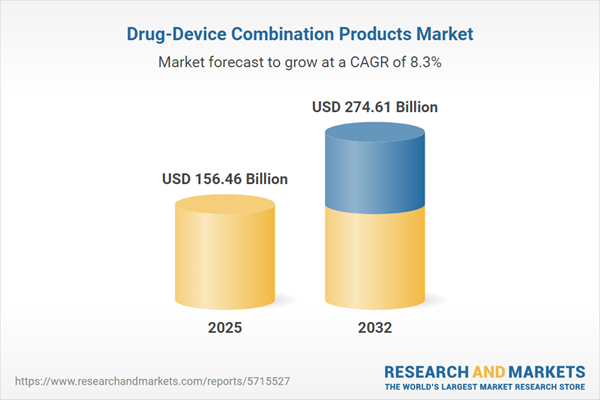Speak directly to the analyst to clarify any post sales queries you may have.
The drug-device combination products market stands at a strategic crossroads for healthcare innovation, delivering integrated therapies that are transforming care delivery and shaping stakeholder priorities worldwide. Senior decision-makers will find immediate value in understanding evolving trends, emerging technologies, and shifting regulatory dynamics driving the sector's next phase of growth.
Market Snapshot: Drug-Device Combination Products Market
The drug-device combination products market grew from USD 144.59 billion in 2024 to USD 156.46 billion in 2025. It is projected to maintain momentum with a CAGR of 8.34%, reaching USD 274.61 billion by 2032. As stakeholders increasingly prioritize therapeutic precision, integrated drug-device platforms are capturing higher clinical adoption and capital investment. Industry growth is shaped by innovations that enable controlled delivery, patient monitoring, and superior adherence—and these dynamics are expected to accelerate as value-based care models become standard in global health systems.
Scope & Segmentation
- Product Types: Drug-eluting stents, inhalers, injector systems including auto-injectors and needle-free injectors, prefilled syringes and pens, topical medicines, transdermal patches.
- Technology: Advanced release technologies, biodegradable technology, conventional device-drug technology, and smart device technologies such as automatic dosing and digital monitoring.
- Dosage Forms: Liquid, semi-solid (creams, ointments, powders), and solid (capsules, tablets) dosage forms support diverse therapeutic indications and administration requirements.
- Therapeutic Class: Cardiovascular medications, diabetes and endocrinology, hormonal replacement therapy, oncology drugs including chemotherapy and participatory oncology treatment, and pain management.
- End Users: Ambulatory surgical centers, homecare settings, hospitals, clinics, and specialty clinics each possess distinct needs for device integration and usability.
- Regional Coverage: Americas (with coverage of North America and Latin America), Europe, Middle East, Africa, and Asia-Pacific including key economic hubs.
- Companies Profiled: Major stakeholders such as Abbott Laboratories, Medtronic PLC, Boston Scientific Corporation, Novartis AG, Fresenius Kabi, and more are analyzed for innovation and market strategy.
Key Takeaways for Senior Decision-Makers
- Integrated product designs are reducing medication errors and improving clinical outcomes, importantly supporting chronic disease management in both hospital and homecare settings.
- Emerging technologies like digital monitoring and programmable dosing align with the push for real-time adherence tracking and patient-centric care models.
- Partnerships between pharmaceutical and medical device companies are expediting innovation pipelines, with collaborative platforms facilitating rapid market entry for novel therapies.
- Advanced materials and sustainability considerations are influencing both product development and procurement strategies as regulatory requirements evolve worldwide.
- Regional markets display distinct adoption patterns: North America leads adoption and innovation; APAC benefits from scale and cost advantages; EMEA faces complex but improving regulatory landscapes.
Tariff Impact: Navigating Cost Structures and Supply Chain Strategies
Implementation of new United States tariffs in early 2025 has created cost pressures, affecting both intermediate component sourcing and finished assemblies. Decision-makers are adapting sourcing models, forming partnerships with domestic suppliers, and exploring alternative materials to optimize production economics. Relocation of assembly operations to favorable regions and the adoption of leaner manufacturing protocols are also modifying competitive positioning and regional manufacturing footprints.
Methodology & Data Sources
This report blends structured interviews with stakeholders—including device engineers, clinical experts, regulatory professionals, and supply chain managers—with high-quality secondary research from journals, regulatory databases, and patent filings. Data triangulation and expert validation workshops ensure integrity and provide actionable conclusions for executive planning and strategy.
Why This Report Matters
- Enables business leaders to benchmark innovation pipelines, product mix, and commercial strategies against key competitors in differing global markets.
- Offers clarity into complex regulatory pathways, supply chain risks, and regional growth strategies essential for sustainable success.
- Delivers up-to-date segment-specific and regional insights to guide resource allocation and new market entry decisions.
Conclusion
The drug-device combination products market continues redefining therapeutic delivery through integrated technology, collaborative development, and targeted innovation. For decision-makers, capturing value will require agility, strategic partnerships, and a robust understanding of evolving market forces and regulatory priorities.
Additional Product Information:
- Purchase of this report includes 1 year online access with quarterly updates.
- This report can be updated on request. Please contact our Customer Experience team using the Ask a Question widget on our website.
Table of Contents
3. Executive Summary
4. Market Overview
7. Cumulative Impact of Artificial Intelligence 2025
Companies Mentioned
The companies profiled in this Drug-Device Combination Products market report include:- Abbott Laboratories
- AbbVie Inc.
- B. Braun SE
- Baxter International Inc.
- Becton, Dickinson and Company
- BIOTRONIK SE & Co. KG
- Boston Scientific Corporation
- Braile Biomédica
- Cardinal Health, Inc.
- CODAN Companies
- Cook Group Incorporated
- F. Hoffmann-La Roche Ltd.
- Fresenius Kabi
- ICU Medical, Inc.
- InSitu Technologies Inc.
- JMS North America Corporation
- Lepu Medical Technology Company
- Medtronic PLC
- MicroPort Scientific Corporation
- Novartis AG
- Shenzhen Mindray Bio-Medical Electronics Co., Ltd.
- SOOIL Developments Co., Ltd.
- Stryker Corporation
- Teleflex Incorporated
- Terumo Group
- Viatris Inc.
- W. L. Gore & Associates Inc.
Table Information
| Report Attribute | Details |
|---|---|
| No. of Pages | 184 |
| Published | November 2025 |
| Forecast Period | 2025 - 2032 |
| Estimated Market Value ( USD | $ 156.46 Billion |
| Forecasted Market Value ( USD | $ 274.61 Billion |
| Compound Annual Growth Rate | 8.3% |
| Regions Covered | Global |
| No. of Companies Mentioned | 28 |









